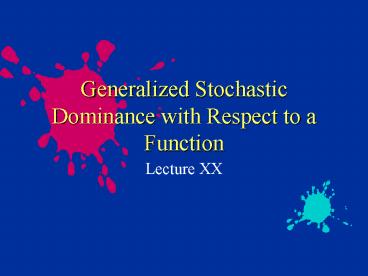Generalized Stochastic Dominance with Respect to a Function - PowerPoint PPT Presentation
1 / 22
Title:
Generalized Stochastic Dominance with Respect to a Function
Description:
The general idea of the manuscript is to restrict the risk aversion coefficient ... the previous derivations, we have the infamous Theorem 5: An optimal control -u' ... – PowerPoint PPT presentation
Number of Views:59
Avg rating:3.0/5.0
Title: Generalized Stochastic Dominance with Respect to a Function
1
Generalized Stochastic Dominance with Respect to
a Function
- Lecture XX
2
Introduction
- Meyer, Jack Choice among Distributions.
Journal of Economic Theory 14(1977) 326-36. - The general idea of the manuscript is to restrict
the risk aversion coefficient for stochastic
dominance to those risk aversion coefficients in
a given interval r1(x)ltr(x)ltr2(x).
3
- This problem will be solved by finding the
utility function u(x) which satisfies - and minimizes
4
- Given that this integral yields the expected
value of F(x) minus the expected value of G(x),
the minimum will be greater than zero if F(x) is
preferred to G(x) by all agents who prefer F(x)
to G(x). - If the minimum is less than zero, then the
preference is not unanimous for all agents whose
risk aversion coefficients are in the state
range. - Another problem is that utility is invariant to
a linear tranposition. Thus, we must stipulate
that u'(0)1.
5
- The problem is then to use the control variable
-u"(x)/u'(x) to maximize the objective function - subject to the equation of motion
6
- and the control constraints
- with the initial condition u'(0)1.
7
- Rewriting the problem, substituting
z(x)-u"(x)/u'(x) yields
8
- The traditional Hamiltonian for this problem then
becomes - Following the basic Pontryagin results, a given
path for control variable is optimum given three
conditions - Optimality Condition
9
- Multiplier or Costate condition
- Equation of Motion
10
- However, in the current scenario the Hamiltonian
has to be amended to account for the two
inequality constraints. Specifically,
11
- First examining the derivatives of the Lagrangian
with respect to z(x), the control variable. We
see that
12
- Given the restriction that the Lagrange
multipliers must be nonegative at optimum, we can
see that - Thus, the minimum value of the integral occurs
at one of the boundaries. The question is then
What determines which boundary?
13
- To examine this we begin with the Costate
condition - Given this expression, we can work backward from
the transversality condition. Specifically, the
transversality condition for this control problem
specifies that
14
- Given this boundary condition, the value of
l(x)u'(x) can be defined by the integral
15
- Hence to complete the derivation, we must
determine the value of the derivative under the
integral - Substituting for l'(x) from the Costate
condition yields
16
- Substituting for z(x) and canceling like terms
yields - Yielding the expression
17
- Merging this result with the previous
derivations, we have the infamous Theorem 5 An
optimal control -u"(x)/u'(x) which maximizes
18
- is given by
19
- The empirical idea is then to determine whether
one distribution is dominated by another
distribution in the second degree with respect to
a particular set of preferences. To do this we
want to know if the integral switches from
negative to positive within the range of risk
aversion coefficients.
20
- Theorem 5 states that the risk aversion which
maximizes the integral will be found at one
boundary or the other depending on the sign of
the integral.
21
- Application
- Assume that G(x)-F(x) is always nonnegative.
Then - for any u'(x) we consider. Thus, the optimal
control for this particular F(x) and G(x) is to
choose -u"(x)/u'(x) equal to its maximum possible
22
- If G(x)-F(x) changes sign a finite number of
times, then we know that for some x0, G(x)-F(x)
does not change sign in the interval x0,1.
Thus, the optimal solution in x0,1 is given by
the above, and once the solution in x0,1 is
known, the solution of 0,x0 can be calculated
by Theorem 5.































